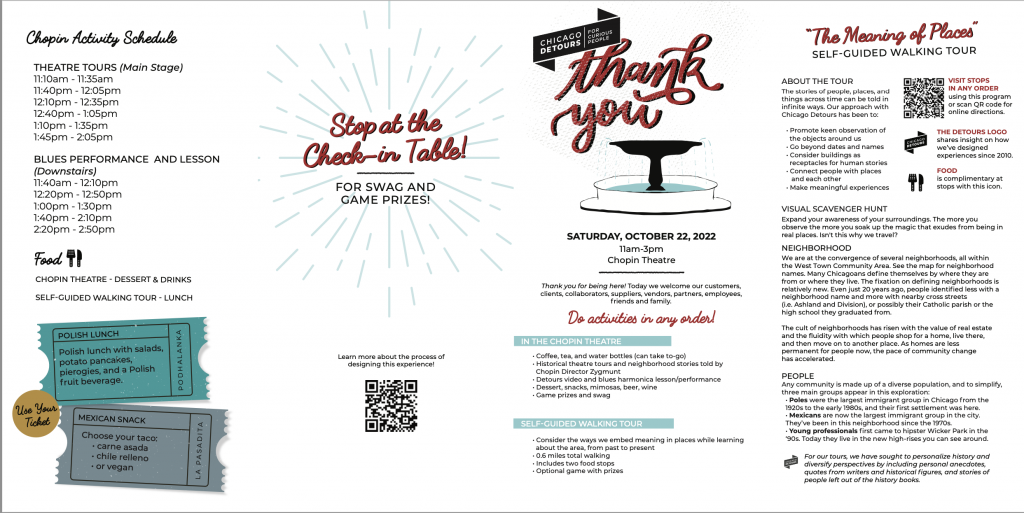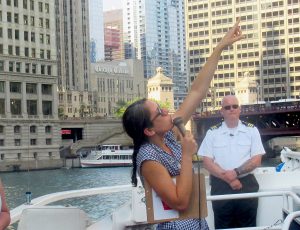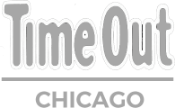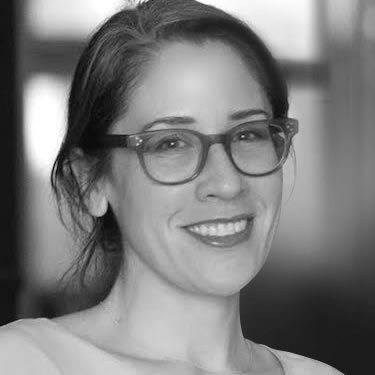
Estimated read time: 8 minutes
DESIGN PROCESS
Read more about the ideas behind designing this special event as a neighborhood exploration with food, music, and learning, driven by the desire to express gratitude to our community.
CONTEXT
Chicago Detours has pivoted. We now focus on what we do best – designing customized experiences. We tell stories that connect people to places and each other.
Previously our strategy was to develop a product – a tour – and then sell and offer it over and over. In 2020 we were slated to be offering 20-30 tour experiences a week to the general public, student groups, and corporate groups. Now, we manage a smaller number of custom projects that require our skills in storytelling, experience design, place engagement, and community building. See some examples of our work here.
EVENT GOALS
Primary goal
To thank our partners, collaborators, vendors, suppliers, friends and family for their support of Chicago Detours over the years, and for helping us get to our next phase in business. Now, instead of offering a volume of public tours, we specialize in carefully designed custom experiences that engage people with places.
Secondary Goals
1. Bring together a community bound by curiosity for historical stories, design, and anything in the world around them. It’s always fun and fascinating when we’ve brought people together.
2. Celebrate 12 years in business with our community and give them an event that prioritizes their needs and enjoyment more than promoting our business.
3. Offer guests a Chicago Detours experience. Now that we no longer offer public tours, individuals will rarely have the opportunity to explore Chicago with us.
4. Demonstrate how place-based storytelling enhances our feelings towards places and can build meaning into our lives. Companies are struggling to create meaning for employees and motivate them to go to the workplace. Place-based storytelling is a powerful way to boost connection with the office as a part of a workplace experience strategy.
5. Share how our thematic storytelling can enliven events in formats other than live, guided tours (i.e. printed content, video, activities led by outside experts).
EVENT FORMAT
Due to COVID, we wanted to make sure people would feel safe. Any large crowds culminating together would not work. We chose to design the event with an open house style, where people could filter through instead of being crowded all at once into a theater, bus, or other event space.
This event format would also fulfill another guest need – people want to do things on their own schedule and their own terms. This is a trend in the world of events. We didn’t want people to be able to feel restricted by the strict timings of a tour and a set route. The open house style of event gives guests agency in “choosing their own adventure.”
Initially we figured the self-guided walking tour would be on an app. However, we tested out various apps and found that they all either had limited capabilities or were too complicated for users. And we really didn’t like the idea of people staring at their screens during a social event. Tour apps are incredibly effective in contained spaces like museums. However when you’re outside, they can disconnect you from the surroundings and even be unsafe, especially if there’s an audio component.
In true Chicago Detours style, we decided to use the time-tested medium of printing for the self-guided tour content and event program. (See both sides of the folded document here).
Regarding the time of day – we didn’t have a lot of flexibility. We were sure we wanted to do it at the Chopin Theatre, and they have limited availability. When designing an event, one has to reconcile the needs of the guests and the needs of the company within what is feasible.
And of course people come together over food and drink! We toyed with the idea of having the food at the Chopin, but really I wanted people to have the special experience of being inside the restaurants. So we reserved tables at the two stops: one for a taco, reflective of the Mexican immigrant community, and the other for a full Polish lunch with cucumber salad, beet salad, pierogis and potato pancakes.
CONCEPT
The idea of centering the entire event around gratitude was an easy choice! We are very excited about our next phase in business, and couldn’t have done it without all the support.
In developing tours around a certain concept, I usually start with a general idea, and it isn’t until I’ve done a lot of brainstorming, discarding ideas, and a certain amount of brain-bending that I uncover the message that I truly want to share and what experiences I want to design in order to share it.
While all of our tours have had topics (i.e. nightlife history, neighborhoods, interior architecture), they also have had underlying themes that have made them more akin to a documentary film than a jumble of dates and names. For this self-guided walking tour, it was quite a challenge to develop a concept within a limited word count!
We chose the “Meaning of Places” as a theme for the self-guided walking tour because
- Post-covid, people are looking for more meaning in their lives.
- The concept can resonate beyond the tour and into people’s personal explorations.
- It gives us the opportunity to showcase one of our core competencies: place-based storytelling.
LOCATION
The location, of course, is a big part of what we do with Chicago Detours. We wanted to bring people to a special, historic venue like the Chopin Theatre – where the architecture and vibe both inside and out is singular.
Then just next door, both La Pasadita and Podhalanka have been favorites among the Detours staff. When I first stepped into Podhalanka years ago, it almost brought me to tears as it smelled like my Polish grandmother’s house.
SELF-GUIDED TOUR RESEARCH
 Five years ago, we launched the “Old Polonia and Wicker Park Walking Tour with Food.” We researched the history behind the neighborhood and buildings. Books, magazine articles, and landmark designation reports are standard resources. Other sources for our stories are walking and observing to uncover “clues”, and talking with people who have lived the history.
Five years ago, we launched the “Old Polonia and Wicker Park Walking Tour with Food.” We researched the history behind the neighborhood and buildings. Books, magazine articles, and landmark designation reports are standard resources. Other sources for our stories are walking and observing to uncover “clues”, and talking with people who have lived the history.
CREATIVE PROCESS
Regarding the overall vision for the event, I had conversations with numerous potential attendees to make sure the experience design would be both intriguing and logistically feasible. Their ideas and feedback guided the shape of the event as a whole.
For the self-guided walking tour, I unrealistically had the idea I would be able to just paste information from our previous walking tour we had created in the neighborhood.
I knew we would have to push further though. We brainstormed a lot of possible themes around history, stories, design, human connections, gratitude, and the motto of Chicago Detours to bring curious people to explore stories and places locals don’t know. I’d decide on one theme, for example, and start developing how I might build that theme through the experience, the activities, social interactions, and media like video or written content. And then it might end up at a dead end and I’d start the process all over.
When I feel like I’m onto something, I like to bounce ideas off other people and make sure that what is in my head can properly translate to others, that it will get them excited, too. In brainstorming sessions with the team (see below), sometimes we are just throwing the spaghetti at the wall and seeing which paths inspire us.
GRAPHIC DESIGN
We wanted some kind of image to represent the event. Ideas we threw in the trash included flags for various countries, a triangle, and some ornate historic graphics.
The fountain, as the physical center of the Polish Triangle, and both the fixture of it, was the winner. The water erupting looks celebratory (like a bottle of champagne), and most of all, the issues around the dedication of the fountain reveal the complexities of community changes. (As a refresher, many Poles opposed the naming of the fountain for how the author Nelson Algren depicted Polish people).
The graphic design for the program and map was a beast. It started with about double the word count, and with aggressive editing, we created a document that is digestible to someone reading it while standing on a sidewalk, and with stories that build a theme.
TEAM
As the creator of Chicago Detours, I have a vision that I get pumped about and then I rally others to be a part of my team to make it happen. Without the support of collaborators, none of this would be possible! I need feedback and other perspectives. Many people contributed to the design and production of the experience:
Primary Consultant for Event Planning and Production – Courtney White
Experience Design – Klaudia Siczek
Content Editing – Marie Rowley, Eve Wilson
Event Concept Collaboration – Cheryl Stoneking (Fox Valley Score), Ellen Bushong, Mariah Cherem, Onna Solomon
Video Concept Collaboration – Donald Harrison (7 Cylinders Studio) and Jillian Elizabeth
Graphic Design – Elissa Martin and Sarah Hammond
Event Planning – Zygmunt and Lela Dyrkacz (Chopin Theatre)
Proofreading – Alex Bean
Communications – Todd Walton, Laurie Scotese
IN SUMMARY
The event included the following elements for guests:
- Exploring new spaces
- Learning a new skill (blues harmonica)
- Playing a visual scavenger hunt game that encourages new ways of looking
- Interaction with historical artifacts
- A writing activity and a meaningful gift to give to someone (a stamped postcard)
- Communal eating
- Conversation prompts
- Self-reflection
- Branded gifts, including one that distinctly connects with both the location of the event and the story
THANK YOU
Again, THANK YOU, to everyone who came and who contributed to the event design. And thank you for reading more about our process. If you’re interested in talking about experiential design and place-based storytelling for community building, please email me at amanda@chicagodetours.com or call 312.350.1131.
-Amanda Scotese
















